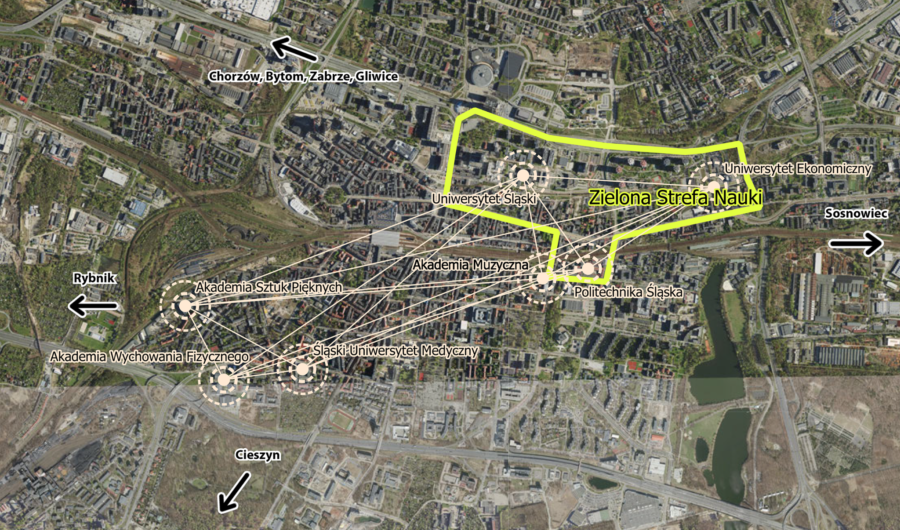One of the pillars of the City of Science is pursuing changes in the urban space and creating new infrastructure to provide the inhabitants and users of the City of Katowice with the opportunity for daily meetings with science. The most significant planned changes concern:
- creating the Green Science Zone in the centre of Katowice,
- creating the Network Science Centre in the region,
- restoring the possibility to use the surroundings of the Rawa river for the inhabitants.
The academic community in consultation with the City of Katowice, Metropolis GZM, and Marshal Office of the Silesian Voivodeship has been conducting analyses necessary for the transformation of public spaces in the academic campuses and the city, and for obtaining the resources required to implement changes, for almost 2 years. There are also social consultations, field examination, and campaigns conducted in order to improve the condition of the Rawa river and social transformation around the Rawa boulevards.
The academic circles of the universities associated in the Consortium have proposed initiatives and concepts of changes in the spirit of New European Bauhaus and consistent with the sustainable development goals. Some of the most important elements include the greening of campuses and adherent spaces as well as pursuit of sustainable mobility.
What will the Green Science Zone be like?
The Green Science Zone is at the same time an experiment and instrument for transformation of the centre of Katowice, the whole city, and region through advanced science and education. Five entities participating in these actions – City of Katowice, Metropolis GZM, University of Silesia, Silesian University of Technology, and University of Economics – are connecting their individual investment plans for the first time to create scientific and educational tools to improve the quality of life in the city and the region. The revitalisation of Rawa and its banks will become a visible and suggestive evidence for the involvement of regional scientific centres in improving the quality of life for the inhabitants
Rawa, revitalised and restored to its natural condition, is to become the axis of the Green Science Zone. The axis will run through the Katowice university campuses, fulfilling the users’ needs in terms of becoming a place to spend free time and get in contact with science. Works on the first visualisations and concepts of changes in the space on Rawa are currently in progress. The Science Zone will involve commercial and social initiatives resulting from academic experiences at the intersection of education, science, business, and social needs. There are plans to create a programme to support initiatives serving the community staying within the Science Zone (academic community, inhabitants, commercial entities).
However, in particular the Green Zone will be the place where the urban and academic tissues permeate, available for everyone all the time – the place to get to know and experience science.
Information in media:
- Katowice becomes the European City of Science 2024
- Silesian Voivodeship and Metropolis GZM work with universities to develop a Science Zone
- Green Science Zone next to the University of Silesia. Rawa as the project’s central part
- Green Science Zone and Network Science Centre in Katowice presented at WUF11
What will the Network Science Centre be like?
Concept sharing some ideas and space with the Green Science Zone. The Network Science Centre (SCN) is designed to ultimately become a joint organism of the universities and the city, available for all inhabitants. In practice, SCN elements will be located throughout the whole region, within the space of the Consortium universities and partner scientific institutions.
The Science Network Centre elements are to ensure the contact of recipients with the ongoing effects of Silesian scientists’ work as well as allow them to observe the activities they undertake.
In the Science Network Centre, the recipients will be able to ask scientists questions, thus inspiring research conducted in accordance with the idea of bottom-up research activities. It will also be possible to participate in citizen science-type research. Currently, conceptual work is conducted on the functionality and programme offer of the Science Network Centre in cooperation with domestic and foreign experts in science communication.
What are the Consortium universities’ goals towards the Network Science Centre?
- joint development in terms of citizen science
- providing space to present the effects of scientists’ work and promote Silesian science
- inspiring scientists to conduct regional research and inspiring inhabitants to look for answers with scientists (e.g. by launching the so-called ‘scientific problem point’ for the inhabitants)
- opening the university to all by providing the space where they will be able to use scientific achievements of a particular university, contribute to research, and ask questions
- professionalisation in the field of scientific communication at universities
- increasing the recognition of the most important scientific achievements of Silesia
How can the Centre differ from others initiatives?
Thanks to the network factor, i.e. its multidisciplinary character and integration with the public space. Thanks to being like a well-designed road network which enables you to get to every point on the map (scientific themes) without getting stuck in traffic. Thanks to being a unique combination of a research, educational, and trend-setting institution (e.g. by supporting startups and initiating discussions).
What impact on the future will it have?
I will have a positive influence on our future in many different ways: by integrating different research projects between universities forming the Consortium, initiating directions for research and discussions, supporting initiatives and technologies, and particularly by educating those who will create the world of the future.
Why the network centre rather than all units focused in one place?
Because the world is not focused in one place, because its residents are not focused in one place, because each of us has different experiences, intuitions and professional education. It will facilitate education and commercialisation of technologies. And particularly because this is the only way to effectively use the potential of the existing research units, including their infrastructure.
Information in media:
- Katowice and university authorities announce concept for Network Science Centre
- Plans to build Network Science Centre
- Something more than a change in the urban system
- Competition for the Copernicus Science Centre. Different than in the capital
- Green Science Zone and the Network Science Centre in Katowice presented during WUF11
Why is Rawa important?
We believe that science and education are the repayment of a debt incurred towards many generations of inhabitants in our region affected by health-deteriorating jobs, ecological destruction of the environment, wasteful exploitation of mining resources, as well as social problems typical for industrial areas. The universities in the city and region should undertake broad, multidisciplinary cooperation in order to ensure systemic diagnosis and modelling of solutions to the problems faced by the city and region. It cannot be done separately. For this purpose, chemical and biological sciences, medicine and technology, social sciences, humanities, and education must cooperate with one another, as well as with local government units and business entities in the region. The universities in Katowice and Silesia should be a great public think-tank serving the city and the region inhabitants.
Rawa is an example of debt incurred by the region inhabitants towards nature and an example of long-term environmental neglect. However, it still is alive, and the river flows through the very heart of Katowice. Once the river has been noticed, it can no longer be forgotten. Scientists together with the City of Katowice and the institutions which care for the river will try to experiment with Rawa by creating the first joint social laboratory around it – the Rawa Laboratory.
The fifth, outdoor edition of the Silesian Science Festival KATOWICE contributed to changing the way of thinking about Rawa. It made us aware of the integrating value of the river and connected the urban tissue with the academic world. Since then, we have been trying to talk about Rawa together and build social activism around it.
The first spatial prototyping near the Rawa boulevards, carried out in 2022, resulted in the European Commission’s award for Metropolis GZM and the University of Silesia in Katowice in the Mobility Action contest for the activities towards the process of prototyping to restore the Rawa space along the Rawa boulevards. The awarded idea consists in transforming the car park near the university campus into an interactive green pedestrian area. The prototyping project was carried out by Metropolis GZM and the University of Silesia with the support of the City of Katowice and universities associated in the Academic Consortium.
More about the award:
- Success for the Metropolis GZM and the University of Silesia. Transformation of a part of Katowice by the Rawa river with an award from the European Commission
- Project for change by the Rawa river recognised in Europe. It has been nominated for the Mobility Action award
In 2022, the Academy of Fine Arts and Design in Katowice invited the inhabitants of Katowice to the exhibition about Rawa. The universities recently carried out clean up actions at Rawa sections, inviting the inhabitants and students of schools in Katowice to work together with them. This is just the beginning of building social support for changes around Rawa. However, it seems that with the City of Science, the river has been noticed again, and both the academic community and the inhabitants felt that they should give it more attention and share their knowledge.
DOWNLOAD FILES:
PrzepRawa. Wywiad z rzeką Katowice is a joint publication of the University of Silesia and the Academy of Fine Arts and Design, which had its premiere during the sixth edition of the Silesian Science Festival KATOWICE. It is a unique collection of poetry, prose and photography concerning Rawa.
Information in media:
- We’re changing Rawa river! Urban prototyping process
- The Rawa river has inspired students of the Academy of Fine Arts and Design. The artworks can be viewed until the end of July
- Theme: the river – the Academy of Fine Arts and Design in Katowice, the Silesian Museum and Metropolis GZM take an interdisciplinary approach to the Rawa river
- We’re changing Rawa river! Take part in prototyping!
- ŚFN on Tour by the Rawa river
- Talks about Rawa
- Rawa prototyping with the European Commission’s award in the MobilityAction competition
- Can the Rawa river be an attraction for Katowice and the University of Silesia? Join us for a walk and talk
- Network Science Centre and Green Science Zone | Press Briefing
- Continued work on prototyping space on the Rawa River









